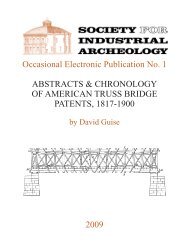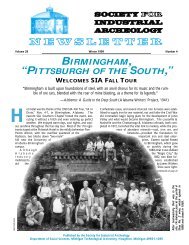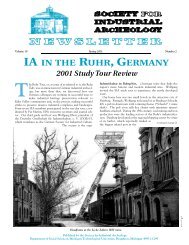SIAN - Society for Industrial Archeology
SIAN - Society for Industrial Archeology
SIAN - Society for Industrial Archeology
Create successful ePaper yourself
Turn your PDF publications into a flip-book with our unique Google optimized e-Paper software.
Lance Metz<br />
2005 General Tools Award Recipient<br />
At the Annual Business Meeting in Milwaukee,<br />
Committee chair Pat Malone announced that<br />
Lance Metz was the 2005 recipient of the General<br />
Tools Award. Lance may be the most avid IA enthusiast<br />
of all time. He is a tireless preservationist and a<br />
compulsive collector of artifacts, illustrations, and documentary<br />
records. However, preservation and collection<br />
are not the only ways in which he has protected the record<br />
of past industries; he has also contributed significantly to<br />
industrial documentation through oral history, photography,<br />
archival research, and public interpretation in various<br />
media—from exhibits to films, television productions, symposia,<br />
festivals, lectures, books, and articles.<br />
Lance has been the Historian of what is now the<br />
National Canal Museum <strong>for</strong> over twenty years, stuffing its<br />
storage shelves with artifacts and filling its archives to bursting—creating<br />
an invaluable record of industries along the<br />
canals of the Lehigh Valley and beyond. Whenever he has<br />
discovered an important collection, he has found a way to<br />
acquire it—as he did with the Crane Iron Works collection,<br />
a treasury of ledger books that document the first<br />
anthracite-fired iron works.<br />
Nothing that threatens our industrial heritage escapes his<br />
attention. For instance, he recognized that the last remnants<br />
of Pennsylvania’s silk industry were rapidly disappearing.<br />
Organizing a team ef<strong>for</strong>t to document every mill structure<br />
still standing, he raised funds to photograph the mills, collect<br />
oral histories, and interpret the history of silk manufacturing.<br />
He even produced a documentary film on this industry.<br />
He has given his heart and soul to the ef<strong>for</strong>t to save “The<br />
Steel.” As he told the Philadelphia Inquirer, “You cannot<br />
touch the history of the 20th century without touching the<br />
history of Bethlehem Steel.” He planted the seed and con-<br />
Frederic L. Quivik—2005 Vogel Prize Winner<br />
Each year the SIA recognizes outstanding scholarship within<br />
the field of industrial archeology with its Robert M. Vogel Prize.<br />
The award honors the author of the best article to appear in the<br />
<strong>Society</strong>’s journal, IA, within the past three years. Articles<br />
under consideration have a clearly stated thesis, a well-constructed<br />
narrative, and an understandable conclusion. The<br />
analysis of material culture plays an important role in articles<br />
considered <strong>for</strong> the prize, as does the use of high-quality illustrations.<br />
The prize consists of a cash award and a wooden<br />
foundry pattern and plaque engraved with the recipient’s name.<br />
At the 2005 Annual Business Meeting in Milwaukee,<br />
this year’s award was presented by Greg Galer, on behalf<br />
of Larry Gross, this year’s Vogel Prize Committee Chair,<br />
to Frederic L. Quivik <strong>for</strong> his article Landscapes as<br />
<strong>Industrial</strong> Artifacts: Lessons from Environmental History,<br />
published in IA Vol. 26, No. 2 (2000), pp. 55-64.<br />
Fred sets the stage with a careful review of the shifting<br />
emphasis of scholarship. Environmentalism has brought<br />
an interest in environmental history and scholars have<br />
begun to develop a history of industry and the natural as<br />
well as the built environment. Just as industrial archeology<br />
has broadened its scope from recording structures and<br />
processes, to industrial complexes, to the human environments<br />
of workers, managers, and owners, Fred adds the<br />
larger biological landscape. He carries the field out the<br />
factory’s back door to see where the waste products go, and<br />
who ends up dealing with them. This approach enables<br />
him to reveal, explore, and contextualize competing<br />
visions of Western development. Using the physical evidence<br />
of the built and biological landscape (albeit in this<br />
case built of slag and filled with toxic tailings), court cases,<br />
and the testimony of parties as disparate as ranchers,<br />
(continued on page 20)<br />
smelters, and <strong>for</strong>est rangers, Fred describes divergent contemporary<br />
views of a single landscape. Slag walls and a<br />
channelized creek shift from an oddity to a toxic waste<br />
containment area. He moves on to imagine improved<br />
interpretation not only of the National Park Service’s<br />
Butte site, but also its Grant Kohrs Ranch—interpretation<br />
which becomes more intricate and complex, but also<br />
understandable, meaningful, and ultimately more interesting<br />
and revealing. Fred takes us beyond tales of confrontation<br />
with the natural elements to a battle “to determine<br />
whose vision of the environment would prevail.”<br />
Fred presents a clear and well-argued thesis that<br />
involves a broad new field and engages a wide audience.<br />
He goes beyond process and product to treat issues in a<br />
sweeping environmental context, extending his use of<br />
the site and of industrial archeology, to engage an important<br />
local and national debate. His approach provides us<br />
with a new way to begin to integrate the “brownfields”<br />
aspect of industrial heritage into our more traditional<br />
focus on production technology and infrastructure, thereby<br />
avoiding a perhaps unwitting blind spot in our assessment<br />
of industry’s impact on the world at large.<br />
Fred also answers superbly the critical “So what?” question,<br />
a benchmark <strong>for</strong> all journal submissions that separates<br />
the merely antiquarian from the truly scholarly and<br />
analytical. Fred’s work should encourage future writers to<br />
aim similarly to answer the larger questions that their<br />
findings raise. With Landscapes as <strong>Industrial</strong> Artifacts Fred<br />
clearly demonstrates the value of environmental analysis<br />
to our work.<br />
Greg Galer<br />
6 <strong>Society</strong> <strong>for</strong> <strong>Industrial</strong> <strong>Archeology</strong> Newsletter, Vol.34, No. 3, 2005






